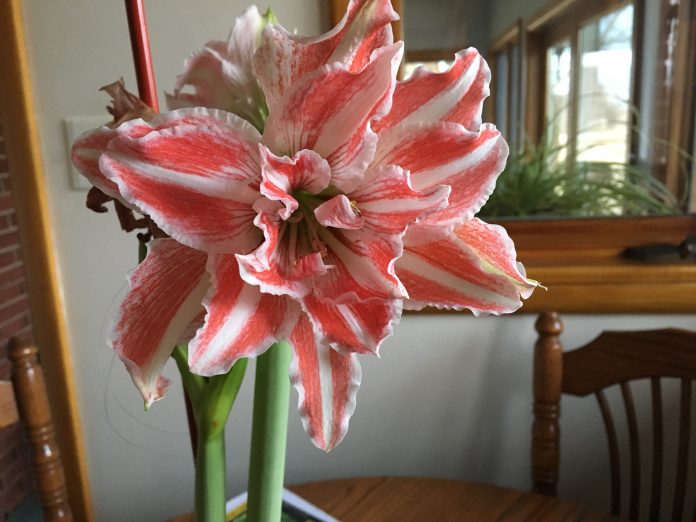Few indoor flowering plants match the beauty of the amaryllis. Known for its large blooms and vibrant colors and patterns, the amaryllis can brighten up any indoor space.
With proper care, you can enjoy your amaryllis year after year as it reblooms each winter.
Blooms
The grandeur of the amaryllis can’t be overstated. The hybrid sold today was developed by the Dutch to produce spectacular blooms. With big showy flowers spanning 4-6 inches in diameter, the amaryllis is sure to catch your eye. And with a wide range of colors and patterns to choose from, there’s something for everyone.
A vigorous amaryllis bulb can produce up to six flowers per stalk.
Amaryllis care cycle
The amaryllis is relatively easy to rebloom if you follow its natural bloom cycle and meet its needs as the seasons change.
Planting bulbs. You want to select healthy bulbs with their original roots intact. Then you’ll need to choose containers that are at least 2 inches wider than the diameter of your bulbs to use for planting. Next, plant the bulbs in a moist, but well-drained, highly organic potting mix. The University of Missouri Extension suggests a mixture of sphagnum peat, vermiculite and perlite maintained in a slightly acid state. After your bulbs have been placed in containers with growing medium, use a water-soluble fertilizer and feed them according to label instructions. Small bulbs produce only one stalk, while large bulbs are able to produce two or three. Plant your bulbs at least six weeks before you want them to bloom.
Temperatures. The amaryllis does well in high temperatures because it is native to the tropical and subtropical Americas. Make sure to provide daytime temperatures of at least 70 F and nighttime temperatures of at least 60 F. To avoid plant damage, don’t expose your amaryllis to temperatures below 50 F.
Spring. For the plant to rebloom next winter, it needs to make and store food in its bulb to prepare itself. You need to maximize conditions by providing bright light, water and fertilizer. When the last flower fades, cut off the stalks and place the plant in a well-lit area. Let the leaves continue to grow and fertilize according to label directions.
Summer. You can move your plant from a well-lit indoor location to a lightly shaded outdoor setting as soon as the danger of frost passes and temperatures have increased. Be sure to water and feed your amaryllis regularly throughout the summer.
Fall. In September, around Labor Day, you’ll need to force your plant into a period of dormancy so it can rebloom in the winter. Move your amaryllis back indoors and place it in a cool location. During this time, withhold water and let its leaves wither and dry. Then remove the leaves and keep it in a cool location until about 6 to 8 weeks before you want it to bloom again.
Winter. You can bring your amaryllis out of dormancy by watering it and placing it in a well-lit, warm location. In six to eight weeks you’ll be able to enjoy your amaryllis’ big beautiful flowers again.
Separating bulbs. Over time your amaryllis’ bulbs will multiply and occasionally need to be separated. You should do this in the fall after the leaves die. Dig them up and separate them. Then store them in a cool, dry place until you want to bring them out of dormancy in the winter.












